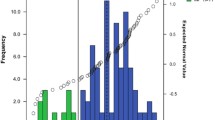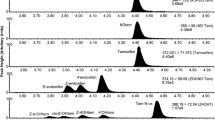Abstract
Purpose
Adjuvant therapy with tamoxifen significantly reduces breast cancer recurrence and mortality in estrogen receptor positive disease. CYP2D6 is the main enzyme involved in the activation of the prodrug tamoxifen into the anti-estrogen endoxifen. Endoxifen is thought to be a main determinant for clinical efficacy in breast cancer patients using tamoxifen. As the large interindividual variation in endoxifen levels is only partly explained by CYP2D6 genotype, we explored the use of the 13C-dextromethorphan breath test (DM-BT) for phenotyping CYP2D6 and to predict serum steady-state endoxifen levels as a marker for clinical outcome in breast cancer patients using tamoxifen.
Methods
In 65 patients with early breast cancer using tamoxifen, CYP2D6 phenotype was assessed by DM-BT. CYP2D6 genotype using Amplichip and serum steady-state levels of endoxifen were determined. Genotype was translated into the gene activity score and into ultrarapid, extensive, heterozygous extensive, intermediate or poor metabolizer CYP2D6 predicted phenotype.
Results
CYP2D6 phenotype determined by the DM-BT explained variation in serum steady-state endoxifen levels for 47.5 % (R 2 = 0.475, p < 0.001). Positive and negative predictive values for a recently suggested threshold serum level of endoxifen (5.97 ng/mL) for breast cancer recurrence rate were 100 and 90 %, respectively, for both CYP2D6 phenotype by DM-BT (delta-over-baseline at t = 50 min (DOB50) values of 0.7–0.9) and genotype (CYP2D6 gene activity score of 1.0).
Conclusion
DM-BT might be, along with CYP2D6 genotyping, of value in selection of individualized endocrine therapy in patients with early breast cancer, especially when concomitant use of CYP2D6 inhibiting medication alters the phenotype.



Similar content being viewed by others
References
Davies C, Godwin J, Gray R et al (2011) Relevance of breast cancer hormone receptors and other factors to the efficacy of adjuvant tamoxifen: patient-level meta-analysis of randomised trials. Lancet 378:771–784
Ohshiro K, Schwartz AM, Levine PH, Kumar R (2012) Alternate estrogen receptors promote invasion of inflammatory breast cancer cells via non-genomic signaling. PLoS One 7:e30725
Furr BJ, Jordan VC (1984) The pharmacology and clinical uses of tamoxifen. Pharmacol Ther 25:127–205
Desta Z, Ward BA, Soukhova NV, Flockhart DA (2004) Comprehensive evaluation of tamoxifen sequential biotransformation by the human cytochrome P450 system in vitro: prominent roles for CYP3A and CYP2D6. J Pharmacol Exp Ther 310:1062–1075
Johnson MD, Zuo H, Lee KH et al (2004) Pharmacological characterization of 4-hydroxy-N-desmethyl tamoxifen, a novel active metabolite of tamoxifen. Breast Cancer Res Treat 85:151–159
Lim YC, Desta Z, Flockhart DA, Skaar TC (2004) Endoxifen (4-hydroxy-N-desmethyl-tamoxifen) has anti-estrogenic effects in breast cancer cells with potency similar to 4-hydroxy-tamoxifen. Cancer Chemother Pharmacol 55:471–478
Wu X, Hawse JR, Subramaniam M, Goetz MP, Ingle JN, Spelsberg TC (2009) The tamoxifen metabolite, endoxifen, is a potent antiestrogen that targets estrogen receptor alpha for degradation in breast cancer cells. Cancer Res 69:1722–1727
Gjerde J, Gandini S, Guerrieri-Gonzaga A et al (2012) Tissue distribution of 4-hydroxy-N-desmethyltamoxifen and tamoxifen-N-oxide. Breast Cancer Res Treat 134:693–700
Lee KH, Ward BA, Desta Z, Flockhart DA, Jones DR (2003) Quantification of tamoxifen and three metabolites in plasma by high-performance liquid chromatography with fluorescence detection: application to a clinical trial. J Chrom B Analyt Technol Biomed Life Sci 791:245–253
Stearns V, Johnson MD, Rae JM et al (2003) Active tamoxifen metabolite plasma concentrations after coadministration of tamoxifen and the selective serotonin reuptake inhibitor paroxetine. J Natl Cancer Inst 95:1758–1764
Singh MS, Francis PA, Michael M (2011) Tamoxifen, cytochrome P450 genes and breast cancer clinical outcomes. Breast 20:111–118
Dezentje VO, Guchelaar HJ, Nortier JWR, van de Velde CJH, Gelderblom H (2009) Clinical implications of CYP2D6 genotyping in tamoxifen treatment for breast cancer. Clin Cancer Res 15:15–21
Goetz MP, Rae JM, Suman VJ et al (2005) Pharmacogenetics of tamoxifen biotransformation is associated with clinical outcomes of efficacy and hot flashes. J Clin Oncol 23:9312–9318
Schroth W, Antoniadou L, Fritz P et al (2007) Breast cancer treatment outcome with adjuvant tamoxifen relative to patient CYP2D6 and CYP2C19 genotypes. J Clin Oncol 25:5187–5193
Damodaran SE, Pradhan SC, Umamaheswaran G, Kadambari D, Reddy KS, Adithan C (2012) Genetic polymorphisms of CYP2D6 increase the risk for recurrence of breast cancer in patients receiving tamoxifen as an adjuvant therapy. Cancer Chemother Pharmacol 70:75–81
Kiyotani K, Mushiroda T, Imamura CK et al (2010) Significant effect of polymorphisms in CYP2D6 and ABCC2 on clinical outcomes of adjuvant tamoxifen therapy for breast cancer patients. J Clin Oncol 28:1287–1293
Nowell SA, Ahn JY, Rae JM et al (2005) Association of genetic variation in tamoxifen-metabolizing enzymes with overall survival and recurrence of disease in breast cancer patients. Breast Cancer Res Treat 91:249–258
Wegman P, Vainikka L, Stal O et al (2005) Genotype of metabolic enzymes and the benefit of tamoxifen in postmenopausal breast cancer patients. Breast Cancer Res 7:R284–R290
Rae JM, Drury S, Hayes DF (2012) CYP2D6 and UGT2B7 genotype and risk of recurrence in tamoxifen-treated breast cancer patients. J Natl Cancer Inst 104:452–460
Regan MM, Leyland-Jones B, Bouzyk M et al (2012) CYP2D6 genotype and tamoxifen response in postmenopausal women with endocrine-responsive breast cancer: the breast international group 1–98 trial. J Natl Cancer Inst 104:441–451
Nakamura Y, Ratain MJ, Cox NJ, McLeod HL, Kroetz DL, Flockhart DA (2012) Re: CYP2D6 genotype and tamoxifen response in postmenopausal women with endocrine-responsive breast cancer: the Breast International Group 1–98 trial. J Natl Cancer Inst 104:1264–1268
Wegman P, Elingarami S, Carstensen J, Stal O, Nordenskjold B, Wingren S (2007) Genetic variants of Cyp3A5, Cyp2D6, Sult1A1, Ugt2B15 and tamoxifen response in postmenopausal patients with breast cancer. Breast Cancer Res 9:R7
Madlensky L, Natarajan L, Tchu S et al (2011) Tamoxifen metabolite concentrations, CYP2D6 genotype, and breast cancer outcomes. Clin Pharmacol Ther 89:718–725
Borges S, Desta Z, Li L et al (2006) Quantitative effect of CYP2D6 genotype and inhibitors on tamoxifen metabolism: implication for optimization of breast cancer treatment. Clin Pharmacol Ther 80:61–74
Jin Y, Desta Z, Stearns V et al (2005) CYP2D6 genotype, antidepressant use, and tamoxifen metabolism during adjuvant breast cancer treatment. J Natl Cancer Inst 97:30–39
Murdter TE, Schroth W, Bacchus-Gerybadze L et al (2011) Activity levels of tamoxifen metabolites at the estrogen receptor and the impact of genetic polymorphisms of phase I and II enzymes on their concentration levels in plasma. Clin Pharmacol Ther 89:708–717
Ahern TP, Pedersen L, Cronin-Fenton DP, Sorensen HT, Lash TL (2009) No increase in breast cancer recurrence with concurrent use of tamoxifen and some CYP2D6-inhibiting medications. Cancer Epidemiol Biomarkers Prev 18:2562–2564
Kelly CM, Juurlink DN, Gomes T et al (2010) Selective serotonin reuptake inhibitors and breast cancer mortality in women receiving tamoxifen: a population based cohort study. BMJ 340:c693
Azoulay L, Dell’Aniello S, Huiart L, du Fort GG, Suissa S (2011) Concurrent use of tamoxifen with CYP2D6 inhibitors and the risk of breast cancer recurrence. Breast Cancer Res Treat 126:695–703
Goetz MP, Knox SK, Suman VJ et al (2007) The impact of cytochrome P450 2D6 metabolism in women receiving adjuvant tamoxifen. Breast Cancer Res Treat 101:113–121
Siegelmann-Danieli N, Kurnik D, Lomnicky Y et al (2011) Potent CYP2D6 inhibiting drugs do not increase relapse rate in early breast cancer patients treated with adjuvant tamoxifen. Breast Cancer Res Treat 125:505–510
Dezentje VO, van Blijderveen NJC, Gelderblom H et al (2010) Effect of concomitant CYP2D6 inhibitor use and tamoxifen adherence on breast cancer recurrence in early-stage breast cancer. J Clin Oncol 28:2423–2429
Yu AM, Haining RL (2001) Comparative contribution to dextromethorphan metabolism by cytochrome P450 isoforms in vitro: can dextromethorphan be used as a dual probe for both CYP2D6 and CYP3A activities? Drug Metab Dispos 29:1514–1520
Leeder JS, Pearce RE, Gaedigk A, Modak A, Rosen DI (2008) Evaluation of a [(13)C]-dextromethorphan breath test to assess CYP2D6 phenotype. J Clin Pharmacol 48:1041–1051
Teunissen SF, Rosing H, Koornstra RH et al (2009) Development and validation of a quantitative assay for the analysis of tamoxifen with its four main metabolites and the flavonoids daidzein, genistein and glycitein in human serum using liquid chromatography coupled with tandem mass spectrometry. J Chromatogr B Analyt Technol Biomed Life Sci 877:2519–2529
Gaedigk A, Simon SD, Pearce RE, Bradford LD, Kennedy MJ, Leeder JS (2008) The CYP2D6 activity score: translating genotype information into a qualitative measure of phenotype. Clin Pharmacol Ther 83:234–242
Modak AS (2007) Stable isotope breath tests in clinical medicine: a review. J Breath Res 4:017002
http://www.photal.co.jp/english/product/poc1_0.html. Visited Nov 5th 2012
de Graan AJ, Teunissen SF, de Vos FY et al (2011) Dextromethorphan as a phenotyping test to predict endoxifen exposure in patients on tamoxifen treatment. J Clin Oncol 29:3240–3246
Sachse C, Brockmoller J, Bauer S, Roots I (1997) Cytochrome P450 2D6 variants in a Caucasian population: allele frequencies and phenotypic consequences. Am J Hum Genet 60:284–295
Frank D, Jaehde U, Fuhr U (2007) Evaluation of probe drugs and pharmacokinetic metrics for CYP2D6 phenotyping. Eur J Clin Pharmacol 63:321–333
Schoedel KA, Pope LE, Sellers EM (2012) Randomized open-label drug–drug interaction trial of dextromethorphan/quinidine and paroxetine in healthy volunteers. Clin Drug Investig 32:157–169
Wu AH, Lorizio W, Tchu S et al (2012) Estimation of tamoxifen metabolite concentrations in the blood of breast cancer patients through CYP2D6 genotype activity score. Breast Cancer Res Treat 133:677–683
Irvin WJ Jr, Walko CM, Weck KE et al (2011) Genotype-guided tamoxifen dosing increases active metabolite exposure in women with reduced CYP2D6 metabolism: a multicenter study. J Clin Oncol 29:3232–3239
Kiyotani K, Mushiroda T, Imamura CK et al (2012) Dose-adjustment study of tamoxifen based on CYP2D6 genotypes in Japanese breast cancer patients. Breast Cancer Res Treat 131:137–145
Ahmad A, Ali SM, Ahmad MU, Sheikh S, Ahmad I (2010) Orally administered endoxifen is a new therapeutic agent for breast cancer. Breast Cancer Res Treat 122:579–584
Ahmad A, Shahabuddin S, Sheikh S et al (2010) Endoxifen, a new cornerstone of breast cancer therapy: demonstration of safety, tolerability, and systemic bioavailability in healthy human subjects. Clin Pharmacol Ther 88:814–817
Acknowledgments
We are grateful to Isotope Cambridge Labs, Inc. for supplying 13C-DM formulation, breath bags and POCone spectrophotometer for the study. We thank the nurse practitioners from the Leiden University Medical Center, Diaconessenhuis Leiden, and Medical Center of Alkmaar for recruitment of patients for this study. We thank the technicians from the pharmaceutical analytical laboratory of the Department of Clinical Pharmacy and Toxicology, for determination of serum levels of tamoxifen and metabolites. We thank Dr. H. Putter from the Departments of Medical Statistics for his contribution to statistical analyses.
Conflict of interest
Dr. A. M. has employment to disclose: Dr. A. S. Modak is Associate Director Medical Products R&D of Cambridge Isotope Laboratories Inc, Andover, Massachusetts, USA. All other authors state that they have no conflict of interest. There was no financial support of any company to this study.
Author information
Authors and Affiliations
Corresponding author
Additional information
Trial registration The Netherlands Trial Register (NTR1509).
Rights and permissions
About this article
Cite this article
Opdam, F.L., Dezentje, V.O., den Hartigh, J. et al. The use of the 13C-dextromethorphan breath test for phenotyping CYP2D6 in breast cancer patients using tamoxifen: association with CYP2D6 genotype and serum endoxifen levels. Cancer Chemother Pharmacol 71, 593–601 (2013). https://doi.org/10.1007/s00280-012-2034-4
Received:
Accepted:
Published:
Issue Date:
DOI: https://doi.org/10.1007/s00280-012-2034-4




